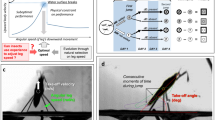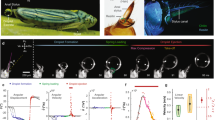Abstract
Water-walking insects and spiders rely on surface tension for static weight support1,2 and use a variety of means to propel themselves along the surface3,4,5,6,7,8. To pass from the water surface to land, they must contend with the slippery slopes of the menisci that border the water's edge. The ability to climb menisci is a skill exploited by water-walking insects as they seek land in order to lay eggs or avoid predators4; moreover, it was a necessary adaptation for their ancestors as they evolved from terrestrials to live exclusively on the water surface3. Many millimetre-scale water-walking insects are unable to climb menisci using their traditional means of propulsion2,3,9. Through a combined experimental and theoretical study, here we investigate the meniscus-climbing technique that such insects use. By assuming a fixed body posture, they deform the water surface in order to generate capillary forces10,11,12,13: they thus propel themselves laterally without moving their appendages. We develop a theoretical model for this novel mode of propulsion and use it to rationalize the climbers' characteristic body postures and predict climbing trajectories consistent with those reported here and elsewhere3.
This is a preview of subscription content, access via your institution
Access options
Subscribe to this journal
Receive 51 print issues and online access
$199.00 per year
only $3.90 per issue
Buy this article
- Purchase on Springer Link
- Instant access to full article PDF
Prices may be subject to local taxes which are calculated during checkout



Similar content being viewed by others
References
Brocher, F. Les phénomènes capillaires. Leur importance dans la biologie aquatique. Ann. Biol. Lacustre 4, 89–139 (1910)
Baudoin, R. La physico-chimie des surfaces dans la vie des Arthropodes aeriens des miroirs d'eau, des rivages marins et lacustres et de la zone intercotidale. Bull. Biol. Fr. Belg. 89, 16–164 (1955)
Andersen, N. M. A comparative study of locomotion on the water surface in semiaquatic bugs (Insecta, Hemiptera, Gerromorpha). Vidensk. Meddr. Dansk. Naturh. Foren. 139, 337–396 (1976)
Andersen, N. M. The Semiaquatic Bugs (Hemiptera, Gerromorpha): Phylogeny, Adaptations, Biogeography and Classification (Scandinavian Science, Klampenborg, Denmark, 1982)
Suter, R. B., Rosenberg, R. B., Loeb, S., Wildman, H. & Long, J. H. Locomotion on the water surface: Propulsive mechanisms of the fisher spider Dolomedes triton. J. Exp. Biol. 200, 2523–2538 (1997)
Suter, R. B. & Wildman, H. Locomotion on the water surface: hydrodynamic constraints on rowing velocity require a gait change. J. Exp. Biol. 202, 2771–2785 (1999)
Hu, D. L., Chan, B. & Bush, J. W. M. The hydrodynamics of water strider locomotion. Nature 424, 663–666 (2003)
Bush, J. W. M. & Hu, D. L. Walking on water: Biolocomotion at the interface. Annu. Rev. Fluid Mech. 38, 339–369 (in the press)
Miyamoto, S. On a special mode of locomotion utilizing surface tension at the water-edge in some semiaquatic insects. Kontyû 23, 45–52 (1955)
Kralchevsky, P. A. & Denkov, N. D. Capillary forces and structuring in layers of colloid particles. Curr. Opin. Coll. Interf. Sci. 6, 383–401 (2001)
Chan, D. Y. C., Henry, J. D. J. & White, L. R. The interaction of colloidal particles collected at fluid interfaces. J. Coll. Interf. Sci. 79, 410–418 (1981)
Nicolson, M. The interaction between floating particles. Proc. Cambr. Phil. Soc. 45, 288–295 (1949)
Whitesides, G. M. & Grzybowski, B. Self-assembly at all scales. Science 295, 2418–2421 (2002)
Suter, R. B. & Gruenwald, J. Predator avoidance on the water surface? Kinematics and efficacy of vertical jumping by Dolomedes (Araneae Pisauridae). J. Arach. 28, 201–210 (2000)
Gifford, W. A. & Scriven, L. E. On the attraction of floating particles. Chem. Eng. Sci. 26, 287–297 (1971)
Vella, D. & Mahadevan, L. The ‘Cheerios effect’. Am. J. Phys. 73, 817–825 (2005)
Gryzbowski, B. A., Bowden, N., Arias, F., Yang, H. & Whitesides, G. M. Modeling of menisci and capillary forces from the millimeter to the micrometer size. J. Phys. Chem. B 105, 404–412 (2001)
Manoharan, V. N., Elsesser, M. T. & Pine, D. J. Dense packing and symmetry in small clusters of microspheres. Science 301, 483–487 (2003)
Lauga, E. & Brenner, M. P. Evaporation-driven assembly of colloidal particles. Phys. Rev. Lett. 93, 238301 (2004)
de Gennes, P.-G., Brochard-Wyart, F. & Quéré, D. Capillarity and Wetting Phenomena: Drops, Bubbles, Pearls and Waves (Springer, Berlin, 2003)
Gao, X. & Jiang, L. Water-repellent legs of water striders. Nature 432, 36 (2004)
Dickinson, M. H. et al. How animals move: An integrative view. Science 288, 100–106 (2000)
Alexander, R. M. Principles of Animal Locomotion (Princeton Univ. Press, Princeton, New Jersey, 2003)
Biewener, A. A. Animal Locomotion (Cambridge Univ. Press, Cambridge, 2003)
Vogel, S. Biomechanics: Life's Physical World (Princeton Univ. Press, Princeton, New Jersey, 2003)
Acknowledgements
We thank T. Kreider for his early contributions, B. Chan for his assistance with the illustrations, L. Mendel for photographing Fig. 1a and MIT's Edgerton Center for access to their high-speed video equipment. We gratefully acknowledge the financial support of the NSF.
Author information
Authors and Affiliations
Corresponding author
Ethics declarations
Competing interests
Reprints and permissions information is available at npg.nature.com/reprintsandpermissions. The authors declare no competing financial interests.
Supplementary information
Supplementary Video S1
Many water-walking insects are incapable of climbing menisci using their traditional means of propulsion. Here we see an infant water strider trying in vain to row up a meniscus. Video played at 1/20 real time. Body length, 1 mm. (MOV 9879 kb)
Supplementary Video S2
Here we see Mesovelia attempting to climb a meniscus from right to left. In its first attempt, it tries in vain to scamper up using its traditional running gait. In its second attempt, it locks itself into a fixed posture, pulling up with its front and rear appendages, and thus glides up the meniscus, seemingly effortlessly. Video played at 1/20 real time. Body length, 2 mm. (MOV 10108 kb)
Supplementary Video S3
We see here Mesovelia climbing a meniscus from right to left. The surface deflections are indicated by the shadows cast beneath the insect. Where it pulls up (with its front and rear appendages), the surface deflection focuses light into bright spots; where it pushes down (with its middle legs), light is diffused, resulting in dark shadows. Video played at 1/20 real time. Body length, 2 mm. (MOV 9090 kb)
Supplementary Video S4
We see here the meniscus-climbing technique of the beetle larva, a terrestrial creature not suited to walking on water. As it is circumscribed by a contact line, it can manipulate the free surface by arching its back. In so doing, it generates a torque that twists and aligns it perpendicular to the meniscus, and a force that subsequently drives it up the meniscus. Videos played in real time. Body length, 6 mm. (MOV 7674 kb)
Supplementary Video S5
We see here the meniscus-climbing technique of the beetle larva, a terrestrial creature not suited to walking on water. As it is circumscribed by a contact line, it can manipulate the free surface by arching its back. In so doing, it generates a torque that twists and aligns it perpendicular to the meniscus, and a force that subsequently drives it up the meniscus. Videos played in real time. Body length, 6 mm. (MOV 3424 kb)
Rights and permissions
About this article
Cite this article
Hu, D., Bush, J. Meniscus-climbing insects. Nature 437, 733–736 (2005). https://doi.org/10.1038/nature03995
Received:
Accepted:
Issue Date:
DOI: https://doi.org/10.1038/nature03995
This article is cited by
-
On the reaction–diffusion type modelling of the self-propelled object motion
Scientific Reports (2023)
-
A Review: From Aquatic Lives Locomotion to Bio-inspired Robot Mechanical Designations
Journal of Bionic Engineering (2023)
-
Wetting of Particles Bound by an Elastic Field
Journal of Elasticity (2023)
-
Continuous, autonomous subsurface cargo shuttling by nature-inspired meniscus-climbing systems
Nature Chemistry (2022)
-
How drain flies manage to almost never get washed away
Scientific Reports (2020)
Comments
By submitting a comment you agree to abide by our Terms and Community Guidelines. If you find something abusive or that does not comply with our terms or guidelines please flag it as inappropriate.



